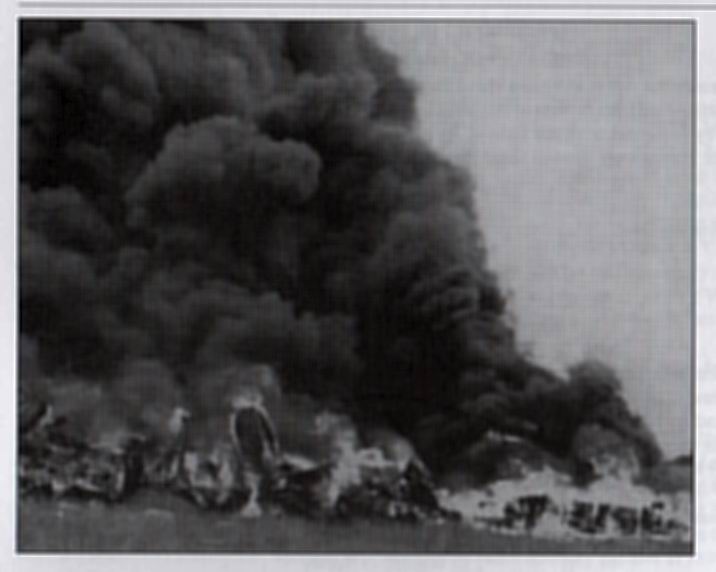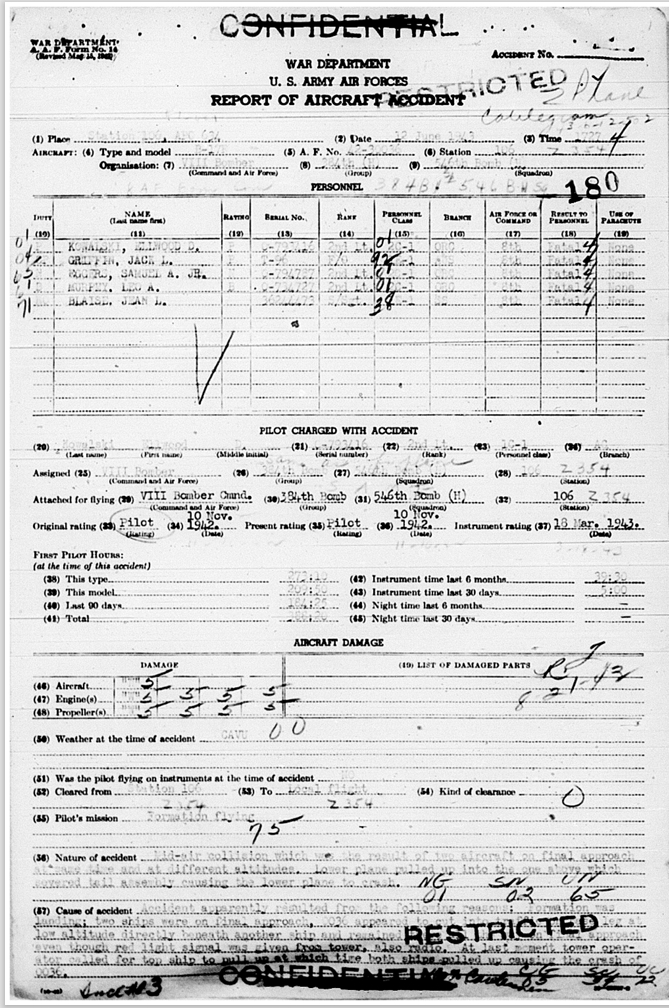
Poor quality image of the wreckage of #42-30036 ablaze shortly after the collision that resulted in the aircraft crashing, with the loss of five lives. Photo courtesy of www.384thbombgroup.com

Copy of the official Crash Report for B-17F #42-30036. Courtesy of www.384thbombgroup.com
B-17F #42-30036, un-named
Last updated: December 1, 2025, 4:40 am| Name: | B-17F #42-30036, un-named |
| Serial Number: | 42-30036 |
| Manufacturer: | Boeing Airplane Company |
| Finish: | Camouflage |
| Squadron: | 546th Bomb Squadron |
| Squadron ID: | BK-? |
| Fate: | Crashed, mid-air collision, destroyed 12/06/1943 |
At just after 5pm on Saturday 12th June, 1943 the 384th Bombardment Group was to suffer its first of many losses of aircraft and personnel in operations from the UK. On approach to landing, B-17F #42-30036 of the 546th Bomb Squadron, piloted by 2nd Lt. David Ellwood Kowalski, collided with B-17F #42-30131. With its tail sheared off by the impact, #42-30036 pitched up out of control, before falling to earth with the loss of all five crew members. It would be a further 10 days before the first combat mission of the 384th Bomb Group was actually flown.
B-17F #42-30036 was an original 384th BG aircraft, having been assigned to the group on 1st June 1943. The five crew members onboard this day were also some of the original personnel assigned to the 384th at Gowan Field, Idaho back on the 11th March, 1943. They were:-
Pilot 2nd Lt. Elwood David Kowalski
Co-Pilot Flt. Officer Jack L. Griffin
Navigator 2nd Lt. Samuel Andrew Eggers Jnr.
Bombardier 2nd Lt. Leo Ambrose Murphy
Radio Operator S/Sgt. Jean Leroy Blaise
The incident highlighted the inexperience of the flight crews at this early stage of operations, and how communications could become easily misconstrued. A sixteen ship training flight had just returned to the airfield and had been instructed to use Runway No.2 (east to west), this was also indicated on the signal square by the Control Tower. However, some confusion had occurred and the returning flight were now lined up instead on Runway No.1 (north-east to south-west). Despite the error being communicated, two returning aircraft still landed on the incorrect runway. Instructions were passed to the formation and actions were taken to realign and enter a landing pattern for the correct runway.
There were several eyewitness accounts provided from personnel present in the Control Tower and on the ground as to how the incident developed, however at certain points the lay of the land had obscured the flightpath of #42-30036.
Sgt. James Boyce, Control Tower Operator - he had been listening, and speaking with, the returning formation. He was able to visually identify the formation but then spotted that the two aircraft had become stacked on top of each other, with an estimated 20-30 feet of vertical separation. He realised they had not spotted each other, and issued the instruction over the radio for the "top plane to pull up". With #42-30036 unaware of the aircraft above them, they assumed the instruction was meant for them and subsequently pulled up.
2nd Lt. James V. Gallagher, Control Tower Officer - he reported that he had spotted the error in the formation lining up on the incorrect runway just after 17:00, and and had instructed the aircraft to go around again by going outside of the Tower building and signalling three red lights. He then spotted #42-30036 cutting a corner off the landing pattern, but lost sight of the aircraft due to an elevation in the land. By the time it re-appeared, it was clear that it sat directly beneath #42-31031 - he flashed a red light to signal the aircraft to go around again, at the same time as Sgt. Boyce's radio call.
1st Lt. Robert E. Langlois had watched #42-30036 come into land and noted a hard landing, at which point it lifted off the runway again. He then watched as both the aircraft then lined up with the runway from about 3 miles, initially with a vertical separation of an estimated 1,000 ft. By the time they were 1,000 ft from the threshold of the runway, this gap was down to a mere 20 feet.
M/Sgt. Frank Priesnitz noted that a red flare had been fired from the Control Tower, and that the lower aircraft then pulled up into the one above.
The Navigator onboard #42-30131 is stated as saying there was confusion onboard their aircraft, with the bombardier calling the pilot, 2nd Lt. Francis J. Witt, several times and instructing him to pull up to avoid the lower aircraft, assumedly having spotted the impending danger through his vantage point in the nose of the aircraft. In his statement, Pilot 2nd Lt. Witt states he 'suddenly' heard the calls to pull up, and did so immediately.
Unfortunately, the calls to 'pull up' from the Control Tower were acted upon by both aircraft, seemingly because #42-30036 was still unaware there was an aircraft above them that the instruction was meant for. The two aircraft collided, with #42-30036 striking the nose area of #42-30031 (apparent in images taken afterwards where the front plexiglass has been broken away), and also the propellor of #2 engine. The collision severed the tail section of #42-30036 just ahead of the horizontal stabiliser, through the edge of the vertical fin. This caused the aircraft to pitch violently up, eventually stalling and falling to the ground where the wreckage burst into flames. The incident occurred at around a height of 50ft, a short distance from the end of the runway in an open field area.
Although initially also pitching up and nearly stalling, #42-30131 quickly levelled off and was able to make a normal landing, with no casualties amongst its crew of nine. The damage to the aircraft was severe though, and resulted in the aircraft being sent to the 2nd Strategic Air Depot at RAF Little Staughton, the maintenance and repair depot for the 1st Combat Air Wing. The aircraft was subsequently transferred into RAF use with 517 Squadron once repairs were complete. It was to be lost in action on 2nd February 1944, with the loss of all eight crew.
An investigation into the collision at Grafton Underwood concluded that it was observed that #42-30036 had made an previous attempt to land, resulting in a 'heavy' landing, before the aircraft pulled away, circled the airfield and re-joined the landing pattern. In doing so, however, the aircraft had cut a corner short, which in turn placed it directly under the flight path of #42-30131 that was approaching correctly. From that point it was deemed that both aircraft were unable to see each other until it was too late, and the radio communication intended for the top aircraft had been actioned by both aircraft at the same time, causing the collision. The recommendation issued as a result of the accident was that Co-Pilots should check regularly for red lights from the Control Tower, signalling that the landing approach be aborted immediately.
Research courtesy of Keith Andrews on behalf of 384th Bombardment Group Museum
With kind thanks to the 384th Bomb Group website (384thbombgroup.com) for permission in using material from their records in the making of this story. It holds a wealth of information, documents and photographs of their activities during World War 2.
Gallery

Poor quality image of the wreckage of #42-30036 ablaze shortly after the collision that resulted in the aircraft crashing, with the loss of five lives. Photo courtesy of www.384thbombgroup.com

Copy of the official Crash Report for B-17F #42-30036. Courtesy of www.384thbombgroup.com